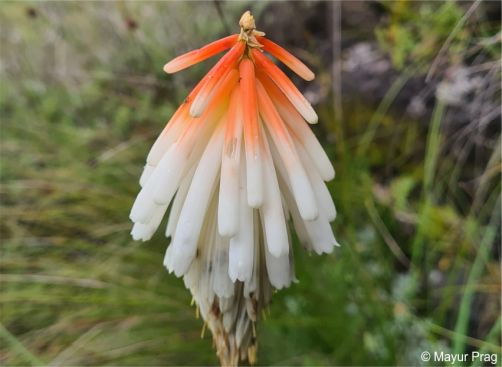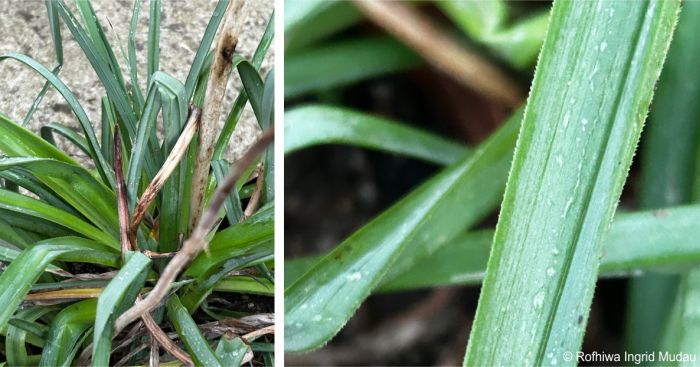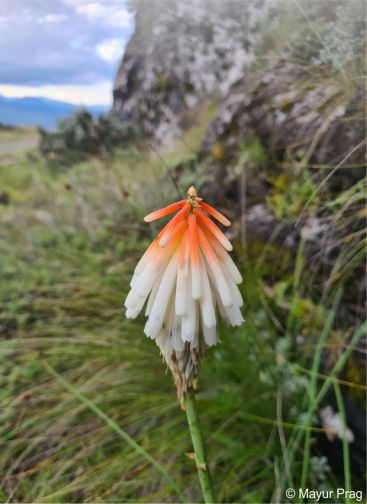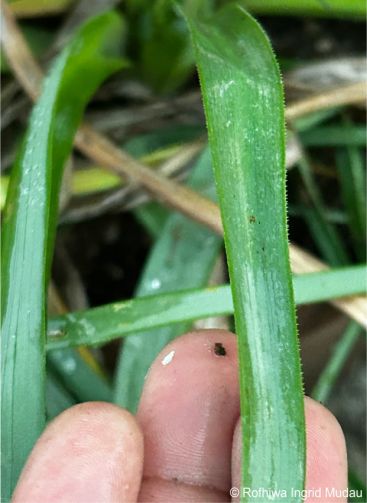Kniphofia thodei
Kniphofia thodei Baker
Family: Asphodelaceae
Common names: Thode’s poker (Eng.); leloele (Sesotho)
Introduction
Kniphofia thodei is a monocotyledonous perennial herb with distinctive bicoloured red and white flowers. Plants are usually solitary, unlike many other pokers that form clumps. It favours damp grassy mountain slopes.

Description
Description
Kniphofia thodei is a dwarf, single stemmed poker. The leaves are pale bluish-green (glaucous), at first upright and later bending downwards (recurved), narrow, 2–5 mm wide and 300–400 mm long, soft and fibrous at the base, finely toothed margins particularly towards the apex, to almost smooth. The flower stalk (peduncle) is 300–500 mm long, extending above the leaves. It bears an ovoid, dense inflorescence about 40–60 mm long and 40–50 mm in diameter that grades from a coral red or reddish orange tip to a yellowish white base. The flowers pendulous, the buds red often with a white tip, the flowers white or tinged with red towards the base. This species flowers from early summer to early autumn (November to March), with a peak in midsummer (January).
Kniphofia thodei is easily identified by its red and white bicoloured flowers, but may be confused with K. porphyrantha or K. triangularis. Distinguishing characteristics for K. porphyrantha are its lemon yellow flowers tinged with red and yellowish green leaves with smooth margins, and K. triangularis has uniformly coloured red, pinkish-red, reddish orange or orange-yellow flowers with spreading lobes when open.

Conservation Status
Status
According to the Red List of South African Plants the conservation status of this species is assessed as Least Concern (LC).
Distribution and habitat
Distribution description
This species is native to the Drakensberg Mountains, occurring in Lesotho and South Africa, where it is found in the Free State and KwaZulu-Natal provinces. Kniphofia thodei grows in moist grassland in the mountains at altitudes from 1 600 to 2 800 m, in sun or shade, in sandy clay soil.

Derivation of name and historical aspects
History
The genus Kniphofia, commonly known as red hot poker, was named in honour of Johannes Hieronymus Kniphof (1704-1763). Professor Kniphof worked at the Erfurt University in Germany as a Professor in Medicine. Kniphofia thodei was first collected by Justus Thode (1859-1932) and the species was named after him. Thode collected his specimen on grassy slopes near the summit of Moperi’s Peak in the Caledon Range near Witzieshoek in the eastern Free State. It was also found in various locations in Lesotho, and in KwaZulu-Natal in the foothills of the Drakensberg and in the Estcourt District.
Kniphofia belongs to the family Asphodelaceae which comprises 10 indigenous South Africa genera and the another 7 genera occurring in other parts of Africa. There are about 750 species with about 70 species of Kniphofia occurring in Africa and 47 species found in the eastern side of South Africa. Kniphofia is closely related to the Aloe genus. The first species of Kniphofia described, namely K. uvaria, was initially named Aloe uvaria because it was mistaken for an Aloe.
Ecology
Ecology
Kniphofia thodei plays a role in providing nectar and pollen to pollinators such as bees, butterflies, and birds. Its brightly coloured flowers make it attractive to these pollinators.

Uses
Use
Kniphofia thodei is primarily cultivated as an ornamental plant. Its striking spikes of reddish orange and white flowers add visual interest and vibrancy to garden beds, borders, and mixed plantings. Gardeners appreciate its ability to attract pollinators such as bees and butterflies. Culturally, as a native plant of South Africa, Kniphofia thodei holds significance in regions where it naturally occurs. This species symbolizes resilience, endurance, and vitality because of their ability to thrive in harsh environments. Although the medicinal use of this species is not documented, some species of Kniphofia are traditionally used in African herbal medicine for various purposes, such as treating skin conditions, fever and wounds. Caution and consultation with knowledgeable sources are essential before using any plant for medicinal purposes.
Growing Kniphofia thodei
Grow
Kniphofia thodei thrives in full sun to partial shade in well-drained soil. It prefers a moderate amount of water, especially during the growing season, but can tolerate some drought once established. The species is generally frost hardy but may benefit from protection in very cold climates. It is a moderately fast-growing plant that may require occasional pruning to remove spent flower spikes and maintain tidy growth. To encourage repeat blooming, deadhead spent flowers regularly. Organic compost can be applied as a mulch to provide nutrients and improve soil structure. It is suitable for containers.
Propagation of Kniphofia thodei can be achieved through sexual and asexual methods, seed and division.
Seeds can be collected from mature flower spikes and sown in a free-draining seed-raising mix. Soil should be kept consistently moist until germination occurs. This method may take longer and is generally less reliable than other propagation methods.
Kniphofia thodei plants can be lifted and divided during the dormant season (winter) by carefully separating the rhizomes. Each division should have a portion of the root system and several healthy shoots. Replant divisions in well-prepared soil.
References
- Codd, L.E. 1968. The South African species of Kniphofia. Bothalia 9: 363–513.
- Coulson, D. 2015. Kniphofia thodei Baker. Clarens News. Online. https://clarensnews.co.za/kniphofia-thodei-baker/. Accessed 15/05/2024.
- Gardening in South Africa. Pokers are tough timeless and quite spectacular. https://www.gardeninginsouthafrica.co.za/pokers-are-tough-timeless-and-quite-spectacular. Accessed 19/05/204.
- Pooley, E. 2003. Mountain flowers, a field guide to the flora of the Drakensberg and Lesotho. Natal Flora Publications Trust, Durban.
- Prag, M. 2023-01. Observation of Kniphofia thodei, Thabo Mofutsanyana District, KZN. iNaturalist. Online. https://www.inaturalist.org/observations/152274367.
- Raimondo, D., Von Staden, L., Foden, W., Victor, J.E., Helme, N.A., Turner, R.C., Kamundi, D.A. & Manyama, P.A. (eds) 2009. Red list of South African plants. Strelitzia 25. South African National Biodiversity Institute, Pretoria.
- Wentzel, J. n.d. Kniphofia thodei. Wild Flower Nursery. Online. https://wildflowernursery.co.za/indigenous-plant-database/kniphofia-thodei/. Accessed 15/05/2024.
Credits
Rofhiwa Ingrid Mudau and Austin Rasirubo
Pretoria National Botanical Garden
June 2024
Acknowledgements: the authors thank Mayur Prag for the contribution of the image of the flowerhead and Lesego Maunatlala for sharing her knowledge.
Plant Attributes:
Plant Type: Bulb
SA Distribution: Free State, KwaZulu-Natal
Soil type: Clay, Loam
Flowering season: Early Summer, Late Summer
PH:
Flower colour: Red, White, Cream
Aspect: Full Sun, Morning Sun (Semi Shade), Afternoon Sun (Semi Shade)
Gardening skill: Average
Special Features:
Horticultural zones








Rate this article
Article well written and informative
Rate this plant
Is this an interesting plant?
Login to add your Comment
Back to topNot registered yet? Click here to register.